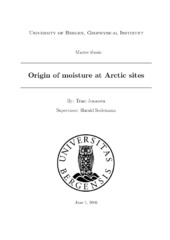Origin of moisture at Arctic sites
Master thesis
Permanent lenke
https://hdl.handle.net/1956/12632Utgivelsesdato
2016-06-01Metadata
Vis full innførselSamlinger
- Geophysical Institute [1195]
Sammendrag
The hydrological cycle is an important component in the understanding of the climate system, and a good understanding of the moisture transport in the atmosphere is important in a changing climate. The climate change may have large impact on the Arctic sites. In this thesis we look at the moisture source for NEEM (North Greenland Eemian Drilling Project) in Greenland (77.45°N, 51.05°W, 2484m a.s.l.) and Tustervatn in Norway (65.83°N, 13.92°E, 439m a.s.l.), by diagnosing the origin of moisture through calculations of a back trajectory, and compare with the interpretation of stable isotope measurements. Stable water isotopes are natural tracers in the global water cycle, and are powerful tools to assess the atmospheric water cycle. The processes involved in stable isotopes is however highly complex, and not fully exploited. This study can be considered as an approach to finding the mean conditions of the moisture source for two Arctic sites, and to investigate and increase the understanding of the stable isotopes. The moisture sources to NEEM and Tustervatn show differences in the transport, between an inland location and a location near the coast, and agreements in their seasonal cycles, e.g. of the moisture uptake. The two Arctic sites also show a clear change from local moisture uptake in the winter to moisture transport from lower latitudes in the summer. The secondary isotope parameter, d-excess, is found to have a high correlation with the latitude, and clear dependencies with the temperature and humidity from the evaporation site and the land fraction. The stable isotopes, δD and δ^18O, are found to have the highest dependencies with the temperature and humidity.
